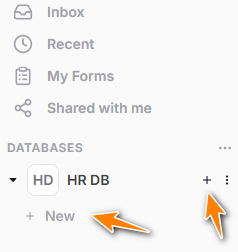Adding Data in AnyDB
Adding data in AnyDB is fast, flexible, and built to match how your team works. Whether you are starting from scratch or using a prebuilt template, this guide walks you through the process.
You can store anything in AnyDB, including:
- Structured Records - Store and organize your business records
- Freeform pages - Add unstructured notes or documentation (just like this one)
- Files and folders - Upload files and organize them your way
** Key Concept: AnyDB Record**
A AnyDB Record is the core structured unit in AnyDB. It can represent anything your business tracks—like a customer, an asset, or a project milestone. Records are flexible, relational, and can be combined with other item types in any database.
Step 1: Start from a Database
Every item you create in AnyDB must belong to a Database. Before creating a new item, ensure you're inside the correct database.
To create a new item:
-
Click the
[+] Newbutton or the[+]icon next to the database name:
-
Or from the listing view, click the
[+] Newlink at the top:
You can create any kind of item—record, page, file, or folder—within a database. Think of the database as the container for everything your team works on.
Step 2: Use the New Item Creation Dialog
After clicking to create a new item, the New Item Creation Dialog appears. You can:
- Browse available templates
- Search by name or description
The dialog is organized into these sections:
🔹 Standard Items
- Record - A structured, customizable record that you can customize from scratch
- Page - A freeform text page for notes or documentation
- File - Upload and store any files and folders
- Folder - Organize related items into logical groups
🔹 Recent
Quick access to templates you've recently used.
🔹 In Your Database
Templates specific to your current database.
🔹 Built-in Templates
A growing library of 100+ ready-to-use templates across business functions. Use them as-is or customize for your needs. See the full list of templates at AnyDB Templates.
🔹 Community-Created (Coming Soon)
In the future, you'll be able to explore templates shared by the broader AnyDB user community.
Step 3: Select a Template
Click any template to preview it.
You'll see:
- A live preview of the record structure
- A short description explaining its use
- A “Learn More” link to view full documentation
- An expand icon to view a larger version
This helps confirm you're choosing the right structure for your needs.
Step 4: Create and Customize
Once you've selected a template, click to create the item. It will open in edit mode immediately.
From here, you can:
- Fill in your data
- Modify fields or structure
- Add relationships, automation, or reminders
That's it! The data is saved automatically as you work and your new item is now part of your AnyDB workspace.